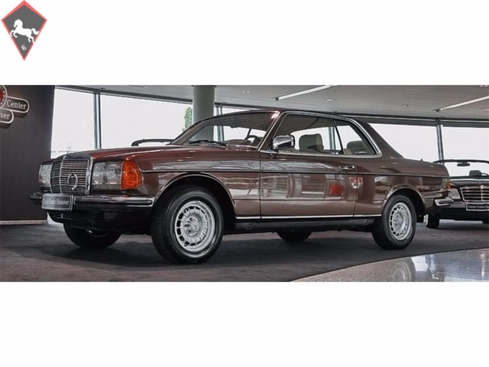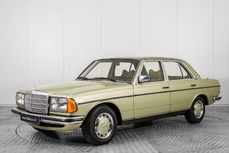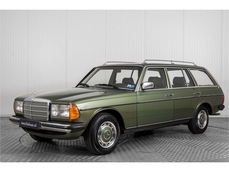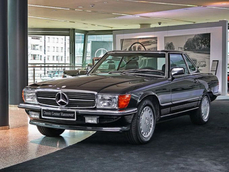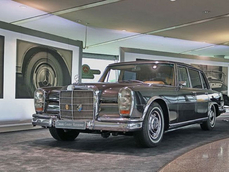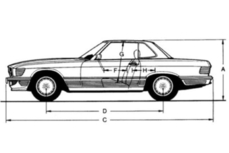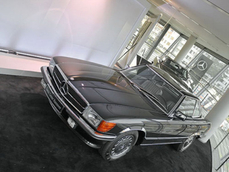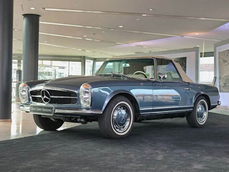Mercedes-Benz 230 w123 CE 1983
General description :
Preis EUR32.850,– (§25a UStG differenzbesteuert)
--- WIR BIETEN DIESES FAHRZEUG IM KUNDENAUFTRAG AN---
Fahrzeughistorie:
Als die Daimler-Benz AG Ende 1975 die neue Mittelklasse-Limousine der Baureihe "W123" der Öffentlichkeit vorstellte, war noch nicht abzusehen, was anschließend geschehen sollte:
Die "schlagartig" einsetzende Nachfrage nach dem neuen Modell katapultierte die Lieferzeit umgehend auf unglaubliche vier Jahre. Es entstand - sehr zum Mißfallen der Vertriebsorganisation - ein schwunghafter Handel mit Lieferverträgen, für die nicht selten 5.000 DM Aufpreis auf den Listenpreis gezahlt wurden, nur um ein Auto schneller zu erhalten. Selbst Jahreswagen wurden deutlich über Neupreis gehandelt. Ein bis dato nie da gewesener Erfolg, der den Mythos der Marke kräftig beflügelte, und den "123er" im Jahr 1980 mit Platz 1 der deutschen Zulassungs-Statistik belohnte.
Der große Erfolg kam nicht von ungefähr: Bereits der Vorgänger - der berühmte "Strich-Acht" - war hinlänglich für seine Qualität bekannt. Der "123" stand ihm im nichts nach, hinzu kamen zahlreiche Innovationen, eine reichhaltige Motorenpalette an Benzin- und Dieselmotoren sowie umfangreiche Möglichkeiten das eigene Auto über Sonderausstattungen zu individualisieren. Während der 10-jährigen Produktionszeit wurden darüber hinaus insgesamt drei - aus heutiger Sicht behutsame - "Modellpflegen" vorgenommen.
Weiterhin gehört eine ebenso wichtige wie folgenreiche Entscheidung des Unternehmens in die Zeit der 123er-Baureihe: Fast zeitgleich mit dem Erscheinen des Coupés im Jahr 1977 debütierte erstmals offiziell eine Kombi-Version. Von den Vorgänger-Modellen gab es bis dahin Mercedes-Kombis nur in Lizenzfertigung und in geringer Stückzahl, das neue Werk in Bremen produzierte das "T-Modell" nun als eigene Modellreihe und eröffnete damit ein neues und überaus erfolgreiches Marktsegment. Die "T-Modelle" gehören seitdem zum festen Bestandteil der Mercedes-Modellpalette und erfreuen sich bis heute größter Beliebtheit.
Dieses Fahrzeug:
Die erste Zulassung dieses Coupés erfolgte auf die Mercedes-Benz Vertretung S&G Automobil-Gesellschaft in Karlsruhe. Nach der damals vorgeschriebenen "Haltedauer" für Vorführwagen von sechs Monaten bekam der neue Besitzer sein Auto ausgeliefert, möglicherweise war das Coupé bereits in dieser Wunschausstattung vorbestellt worden. Die Zulassung erfolgte auf die Firma des Kunden, nach 15 Jahren wurde der Wagen auf "privat" umgeschrieben, blieb demnach 34 Jahre in einer Hand.
Durchschnittlich ergibt sich eine äußerst ungewöhnlich geringe Laufleistung von weniger als 400 KM pro Jahr. Der ebenso außergewöhnlich gute Zustand des Wagens belegt die Richtigkeit der Angabe. Hier wartet eine absolute Rarität auf einen neuen Besitzer...
Sonderausstattungen:
Klimaanlage, Radio Audo 20 Cassette, wärmedämmendes Glas, Automatikgetriebe, Armlehne klappbar vorne, Kopfstützen im Fond, Leichtmetallräder (Fuchs), Tempomat, Metallic-Lack, Zentralverriegelung
Änderungen, Irrtümer und Zwischenverkauf vorbehalten.
https://home.mobile.de/DAIMLERAGMERCEDESBENZCLASSICCENTERHANNOVER#des_247101348
1983 Mercedes-Benz 230 w123 CE is listed sold on ClassicDigest in Podbielskistraße 293DE-30655 Hannover by Auto Dealer for €32850.
Car Facts
Car type : Car Make : Mercedes-Benz Model : 230 w123 Model Version : CE Engine size : 2.3 Model Year : 1983 Sub type : Coupé Location : Podbielskistraße 293DE-30655 Hannover
Sold
Seller Information
Sold
People who viewed this Mercedes-Benz 230 w123 also viewed similar Mercedes-Benz listed at ClassicDigest
Other cars listed for sale by this dealer
About Mercedes-Benz
In the annals of automotive history, the journey of Mercedes-Benz is a tale that unfolds with the ingenuity of its founding pioneers. In the year 1886, Karl Benz crafted the Benz Patent Motorwagen, a creation that would go down in history as the world's inaugural automobile. Unbeknownst to him, this moment marked the genesis of what would evolve into the most illustrious premium car manufacturer globally. The financial underpinning of this pioneering venture, interestingly, was provided by Karl Benz's wife, Bertha Benz, demonstrating a remarkable partnership that would set the tone for Mercedes-Benz's legacy.A parallel narrative emerged not far away, as Daimler-Motoren-Gesellschaft, founded by Gottlieb Daimler and Wilhelm Maybach, entered the scene. In 1901, they unveiled their automobile under the now-famous moniker "Mercedes," meaning "godsend" in Spanish. This name was bestowed upon the car at the behest of Emil Jellinek's daughter, the distributor for Daimler-Motoren-Gesellschaft. The wheels of innovation were set in motion.
Fast forward to 1926, a pivotal year that witnessed the merger of Daimler with Benz & Cie., culminating in the birth of Daimler-Benz. The amalgamation saw the adoption of "Mercedes-Benz" as the distinguished trademark for their automobiles, fusing the legacies of two visionary entities into one.
Contrary to perceptions of conservatism, the trajectory of Daimler-Benz unfolds as a chronicle of industry firsts. From the introduction of the honeycomb radiator to the float carburetor, and the pioneering implementation of four-wheel brakes in 1924, Daimler-Benz consistently pushed the boundaries of automotive innovation. The diesel-powered Mercedes-Benz 260 D in 1936 marked the inception of diesel engines in passenger cars. The iconic Mercedes-Benz 300SL Gullwing made history as the first car with direct fuel injection, albeit the Gutbrod's tiny 2-stroke engine can claim precedence.
Safety innovations became a hallmark, with Béla Barényi's patented safety cell design in the "Ponton"-models in 1951, featuring front and rear crumple zones. The W116 450SEL 6.9 saw the introduction of the Anti-Lock Brake system (ABS), another pioneering safety feature. From the first production airbags and beyond, the legacy of "firsts" continued to be etched into the fabric of Daimler-Benz.
Over its centennial journey, Mercedes-Benz has not merely produced cars but has sculpted automotive icons. The SSKL, 710 SSK Trossi Roadster, 770K Grosser, 540K Spezial Roadster, 300SL Gullwing, w100 600 Pullman, w111 280SE 3.5 Flachkühler, w113 230SL Pagoda, w109 300 SEL 6.3, and w201 2.3-16 Cosworth stand testament to the brand's commitment to engineering excellence.
The roaring Silver Arrows, or "Silberpfeile," including the W 25, W 125, W154, W165, and W196, created a legacy of dominance on the racetrack. These machines were not merely cars; they were expressions of precision, speed, and an indomitable spirit that left their competitors in the dust.
As Mercedes-Benz marches into the future, it does so not just as an automaker but as a custodian of a legacy, a torchbearer of innovation, and a beacon of automotive excellence. The road ahead is sure to witness the continued fusion of cutting-edge technology, timeless design, and an unwavering commitment to setting new standards in the world of automobiles.
One luminary figure who left an indelible mark was Béla Barényi, often heralded as the "father of passive safety" for his pioneering work in safety engineering. His patented safety cell design, featuring front and rear crumple zones, became a hallmark of Mercedes-Benz's commitment to occupant safety, setting new standards that reverberated throughout the automotive world.
Moving through the chronicles, the collaborative genius of Wilhelm Maybach, alongside Gottlieb Daimler, laid the foundation for Daimler-Motoren-Gesellschaft. Their innovations not only birthed the first Mercedes but established a culture of relentless pursuit of technological excellence that remains integral to Mercedes-Benz's DNA.
In the post-merger era of 1926, Ferdinand Porsche emerged as a prominent figure within Mercedes-Benz. His work on the Mercedes-Benz S-Type, a supercharged race car, garnered acclaim and set the stage for a legacy that extended far beyond the marque. Porsche's impact would later extend to his eponymous company, but his influence at Mercedes-Benz during those formative years was pivotal.
As the 20th century progressed, the legendary Rudolf Uhlenhaut emerged as a key figure. Uhlenhaut, an accomplished engineer and the driving force behind the iconic Silver Arrows, played a crucial role in Mercedes-Benz's dominance in motorsports. His engineering prowess and attention to detail were instrumental in creating some of the most formidable racing cars of the era.
In the latter half of the century, figures like Bruno Sacco, the head of design at Mercedes-Benz from 1975 to 1999, left an indelible imprint on the brand's aesthetic identity. Sacco's design philosophy, characterized by clean lines and timeless elegance, shaped iconic models like the W126 S-Class and the W201 190E, solidifying Mercedes-Benz's reputation for luxury and sophistication.
The narrative would be incomplete without acknowledging the contributions of engineers like Hans Scherenberg, whose leadership in the 1970s ushered in a new era of technological innovation at Mercedes-Benz. Scherenberg's tenure saw the development of groundbreaking technologies, including the Anti-Lock Brake system (ABS) and the introduction of airbags in production cars.
